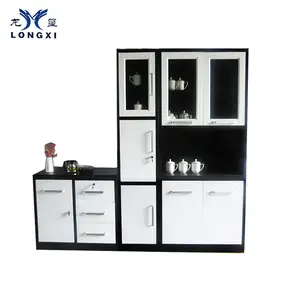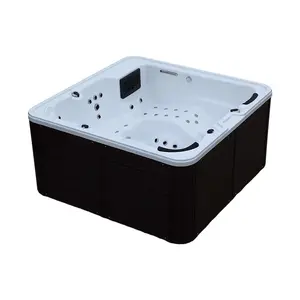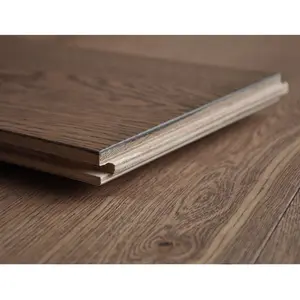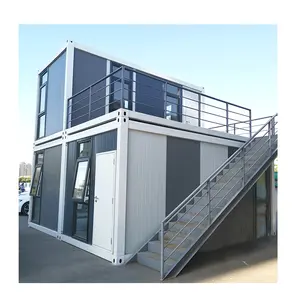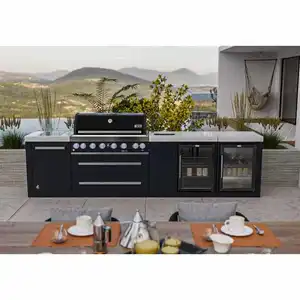Popular in your industry









































































Top categories
About 60 square meters prefab house
Exploring 60-Square-Meter Prefab Houses
Prefabricated houses, commonly known as prefab houses, are buildings manufactured in a factory setting before being transported and assembled on-site. These structures are crafted in a controlled environment, ensuring precision and quality, and are then shipped to their final destination for erection. Prefab houses present a swift, economical, and efficient housing solution, suitable for both personal and commercial purposes.
For private use, prefab houses offer a turnkey solution that can be rapidly established as a dwelling, workspace, or other forms of accommodation. The appeal of prefab homes lies in their ability to bypass the protracted timelines associated with conventional construction. They also provide extensive customization options, allowing for a selection of designs, materials, and finishes to meet particular tastes and functional needs.
Prefab houses are underpinned by the use of standardized components and manufacturing techniques that guarantee consistent quality and reliability. Constructed from materials that are both lightweight and robust, these houses are easy to transport and assemble. The manufacturing process accommodates the integration of electrical and plumbing systems, as well as insulation and other enhancements that contribute to the space's comfort and habitability.
Varieties of 60-Square-Meter Prefab Houses
A diverse array of prefab houses is available, each tailored to fulfill distinct requirements. Below are some prevalent types:
-
Modular Homes: Composed of several units known as modules, these homes are fabricated off-site and then pieced together at their final location. Noted for their adaptability, they can be customized to a range of sizes and design specifications.
-
Panelized Homes: Built from prefabricated wall sections and roof trusses, panelized homes strike a balance between modular construction efficiency and the bespoke nature of traditional builds.
-
Container Houses: Crafted from repurposed shipping containers, these dwellings are both sturdy and environmentally conscious. They are celebrated for their distinctive look and adaptability to diverse environments.
-
Smart Houses: These prefab homes incorporate cutting-edge technology for energy management, security, and convenience, often featuring automated systems for lighting and climate control.
-
Green Houses: Designed with an eye towards sustainability, these homes utilize energy-efficient systems and eco-friendly materials to minimize their environmental impact.
Selecting a 60-Square-Meter Prefab House
When choosing a prefab house for commercial purposes, it's crucial to consider several factors that align with your specific objectives:
First, determine the intended application of the building—be it for transient projects or permanent setups—as this will influence the appropriate prefab house model. For example, modular homes may better serve businesses in the construction or hospitality sectors due to their modularity and scalability.
Next, contemplate the architectural features such as layout, space optimization, and personalization possibilities. A business may favor an open-plan design for its versatility, while others might prefer segmented spaces for confidentiality and organization.
Additionally, scrutinize the quality of materials and the range of services provided by the manufacturer. Opting for a supplier that delivers superior materials and comprehensive services, including design assistance, transportation, and installation, is vital for more ambitious projects.
Moreover, consider sustainability attributes like energy efficiency and eco-friendliness, which not only serve the planet but can also enhance your business's market appeal. Lastly, evaluate other aspects such as after-sales support and maintenance, which can have a significant impact on the long-term operational effectiveness of your enterprise.
Discovering 60-Square-Meter Prefab Houses on Alibaba.com
Businesses seeking a 60-square-meter prefab house on Alibaba.com have access to an extensive selection from global suppliers. This platform stands as a well-established marketplace offering a wide range of prefabricated structures, from residential units to commercial spaces and specialized industrial facilities. Alibaba.com's advanced search tools enable an efficient selection process, tailored to meet precise needs.
Alibaba.com simplifies international commerce with features like Trade Assurance, which safeguards buyers until delivery confirmation. This commitment to secure transactions fosters trust among businesses seeking quality prefab houses without geographic constraints. Additionally, Alibaba.com's mobile-responsive interface allows for communication in various languages and order management on the move—essential for professionals with demanding schedules.
Utilizing Alibaba.com's extensive supplier network and customizable offerings, businesses can confidently procure prefab houses that cater to their operational demands and aesthetic preferences. The platform not only connects buyers with premium structures but also streamlines the procurement cycle from selection to delivery, thereby boosting business efficiency and fostering growth across global markets.
Common FAQs for 60-Square-Meter Prefab Houses
What are the advantages of opting for a prefab house for my enterprise?
Prefab houses boast quicker construction timelines, diminished material waste, and are often more budget-friendly than traditional edifices. They also offer significant adaptability to meet diverse business requirements.
What is the typical assembly duration for a prefab house?
The assembly time for prefab houses can vary, but they are generally assembled much faster than traditional structures, with certain models capable of completion within days or weeks.
Is it possible to tailor the layout and dimensions of a prefab house to my business's needs?
Indeed, prefab houses are highly amenable to customization, allowing for alterations in layout and size to accommodate various spatial needs.
Which materials are frequently employed in prefab house construction?
Typical materials include steel frameworks for structural stability, coupled with panels made from substances like EPS (expanded polystyrene) for insulation, alongside a range of external cladding choices.
Are prefab houses appropriate for all weather conditions?
Prefab houses can be engineered to withstand a variety of climatic challenges. Features such as superior insulation and thermal break materials are available for extreme weather conditions.
How can I ascertain the quality of a prefab house?
To ensure quality in a prefab house, seek suppliers that offer comprehensive product details, maintain quality assurance protocols, and provide third-party inspection options if necessary.
What type of foundation is necessary for a prefab house?
The foundation required for a prefab house varies with the house's design and the site's soil conditions. Typical foundations range from concrete slabs to footings, which must be level and capable of supporting the structure.
Can a prefab house be expanded post-assembly?
Certain prefab houses are designed to allow for future expansion. It is advisable to discuss this possibility with the supplier prior to purchase if expansion is anticipated.
Can a prefab house serve as permanent housing or office space?
Many prefab houses are constructed for permanent residential or office use, equipped with all necessary amenities for long-term occupation.
What is the expected lifespan of a well-maintained prefab house?
A properly maintained prefab house can endure for several decades, provided it is built with durable materials and receives regular upkeep.
How does the weather influence a prefab house?
Climatic conditions can dictate the choice of materials and design specifications for a prefab house. For instance, structures in regions with heavy snowfall may need additional insulation, while those in hotter climates might benefit from materials that promote better ventilation.
